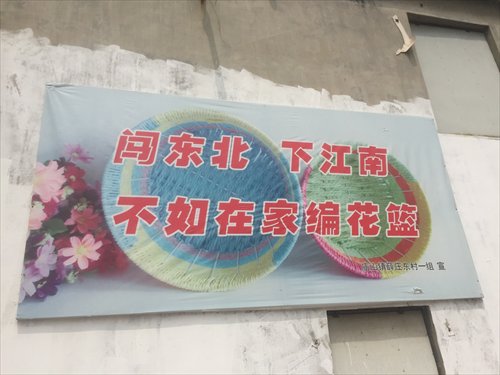
A slogan on a wall in Xuezhuangyicun village, Shandong Province, calls on locals to stay in the village and join the wicker industry. Photo: Xu Liuliu/GT

Li Kuilan works on a traditional Chinese Knot in Honghua township, Shandong Province. Photo: Xu Liuliu/GT
It's a simple task for Li Kuilan to put the finishing touch, a large red tassel, on the Chinese Knot, a traditional symbol representing wishes for happiness, safety and prosperity, that she had been working on. The 80-year-old villager from Honghua, the southernmost township in Shandong Province, can earn nearly 50 yuan ($7.50) a day making Chinese Knots while working and chatting with her neighbors.
Li is one of thousands of villagers in the remote town who the local government hopes to help increase their income by producing cultural heritage products like the Chinese Knot. The biggest Chinese Knot production base in China, the town has more than 17,000 families working on different aspects of the production chain, from manufacturing to transportation and sales, most of which are completed on e-commerce platforms such as Taobao.
Wish for prosperity
Twenty-eight-year-old local man Wang Chao is the owner of the largest Chinese Knot company in China. He also owns the three popular Chinese Knot brands Fuyuanxiang, Jubao and Jiahefushun, as well as nine e-shops on e-commerce platforms like JD, Tmall and Alibaba.
Wang told the Global Times that while he was working in Shenzhen, Guangdong Province, he also ran an e-shop selling Chinese Knots. Rising orders for the cultural product helped him make the decision to return to his hometown and introduce e-commerce to the local industry
"The local government also wants to build Chinese Knots made in Honghua into a brand and so has given me its support from the very beginning," he said.
Wang mainly sells two types of traditional cultural products: sachets for the Dragon Boat Festival and Chinese Knots for Chinese New Year.
"However, 70 percent of our profits comes during the Chinese New Year," he added.
His fast developing business has employed more local villagers, many of whom belong to low-income families.
"About 450 families are making Chinese Knots for me. Each employee earns about 30 to 80 yuan (a day) based on what they produce. For those who want to start their own e-shop, we share our experience and help them set up their own shops," he said.
The township's efforts are also supported by the Shandong provincial government as part of the central government's campaign to combat poverty by capitalizing on local cultural heritage.
In keeping with the "Internet Plus" concept introduced by Premier Li Keqiang, the province aims to make use of the Internet to establish and promote 100 rural cultural projects and local cultural products in 7,005 poverty stricken villages throughout the province. All told, a total of 30 cultural markets dedicated to rural creative industries and traditional arts are expected to be established in the province.
Weaving a new business
About 50 kilometers north of Honghua township you can find Xuezhuangyicun village, whose poverty relief efforts are making use of the local wicker weaving industry. The village's wicker industry has roots that can be traced back to more than 600 years ago. The villagers' works used to be sold throughout Southeast Asia and Europe, but after the global economic crisis in 2008 and the rise of Tabao in China, the village began to shift its focus to the domestic market.
Wandering around the village, numerous slogans encouraging villagers to stay home and work for Taobao instead of heading to the big cities can be seen painted everywhere.
The village's Party Chief Wang Yanping told the Global Times that online sales of wicker products saw a huge increase in 2014, and that by 2015 more than 100 families had their own online shops. "Currently, nearly 80 to 90 percent of families in the village have e-shops selling wicker products. We are forming our own cooperative association now," said the 49-year-old local man.
Wang explained that the success of this local industry has attracted young villagers to come back home to run online shops. Currently, 136 low-income residents are involved in the wicker industry, either focusing on manufacturing side of things, or managing e-shops.
Under the guidance of the provincial government, the Linyi city government in southern Shandong, has established its own projects to combat poverty. The "Dual Ten, Hundred, Thousand" project is one example. The project aims to promote 10 types of woven products, support 100 cultural product businesses and bring 1,000 low-income families involved in the wicker industry. Additionally, the project has hired 10 provincial-level intangible cultural heritage inheritors to be teachers for 100 cultural and handcraft classes that aim to pass on the art of wicker weaving to 1,000 students.

